
As organizations undergo digital transformation, the scope of their software applications, data and digital infrastructure expands significantly. This results in workflows, teams, and data being fragmented across various environments. Some elements remain within local data centers, while others are dispersed across multiple cloud service providers.
Adopting multi-cloud architecture has become a current and future popular trend for most enterprises. Research shows that more than 90% of large organizations have adopted multi-cloud architectures, with their data distributed across multiple cloud service providers.
The importance of a multi-cloud strategy to enterprises cannot be overstated. Multicloud is more than just a technology trend; it represents a fundamental shift in how enterprises leverage cloud resources to achieve their goals.
This article explores the rise of multi-cloud architecture and its impact on business. But first, let’s discuss what multi-cloud architecture is.
What is a multi-cloud architecture?
Multi-cloud architecture is an IT strategy in which companies combine cloud services such as Amazon Web Services, Microsoft Azure, private clouds, and on-site servers. This approach allows enterprises to distribute their essential tasks, applications and data across these different platforms.
In HashiCorp’s first-ever State of Cloud Strategy survey, 76% of more than 3,000 global respondents reported operating in a multi-cloud environment.
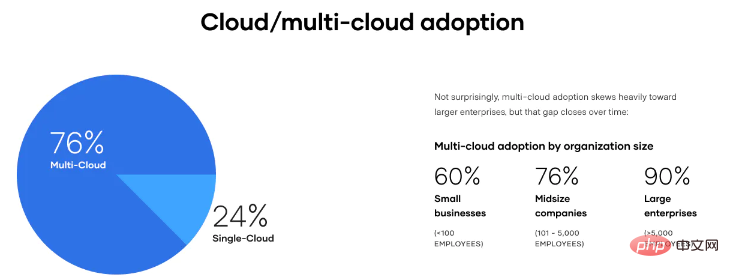
This strategic versatility enables organizations to handpick CSPs based on their unique proficiency, geographic coverage, superior performance, security enhancements, or pricing structure. The result is a fine-tuned cloud environment that leverages each provider's unique strengths to address specific use cases, correct vulnerabilities, and drive business goals.
Benefits of multi-cloud architecture to enterprises
Let us explore the benefits of multi-cloud architecture to enterprises.
1. Enhanced redundancy and reliability
Multi-cloud architecture allows enterprises to distribute applications and data across cloud providers. When one provider fails or is disrupted, services can be seamlessly switched to another provider, ensuring high availability and minimizing downtime.
2. Risk Mitigation
Diversification across multiple cloud providers reduces the risk of vendor lock-in. It allows businesses to choose the provider with the best features and pricing, reducing reliance on a single provider and mitigating potential disruption.
3. Cost Optimization
Multi-cloud enables cost optimization by leveraging competitive pricing and avoiding over-provisioning. Enterprises can match workloads to the most cost-effective cloud providers, resulting in potential cost savings.
4. Flexibility and Agility
Multi-cloud architecture provides the flexibility to quickly scale up or down resources based on changing business needs. It enables agile responses to dynamic workloads and market demands, enabling innovation and growth.
5. Reduce vendor lock-in
Another benefit of a multi-cloud architecture is the reduced risk of vendor lock-in. By leveraging multiple cloud providers, enterprises can avoid overreliance on a single provider's proprietary services, making it easier to switch providers or integrate new ones without major disruption.
Multi-cloud architecture design
In order to develop applications that are widely scalable and provide high reliability, it is appropriate to consider multi-cloud architecture design.
Here, we will explore the well-known multi-cloud architecture methods and strategies during the migration process.
1. Cloudification
When discussing the design of multi-cloud architecture, "cloudification" occupies a prominent position. In this architectural approach, application components are initially hosted locally. Nonetheless, these components can take advantage of various cloud services from different platforms after migration, thus improving their overall performance.
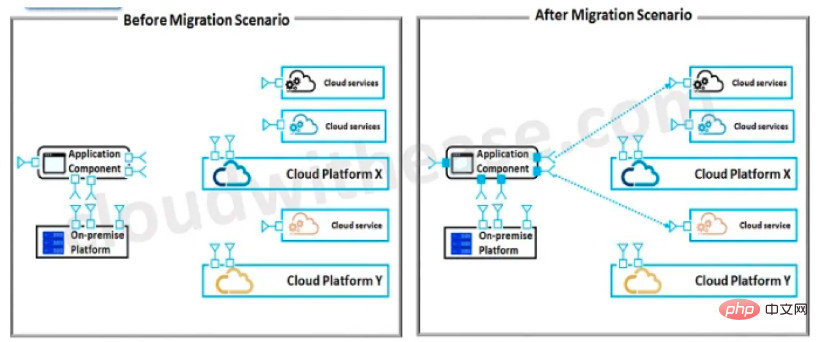
2. Multi-cloud migration
Multi-cloud migration requires physically or virtually moving applications and data from one cloud provider to Another cloud provider, usually to achieve a specific goal such as reducing costs, improving performance, or adhering to compliance.
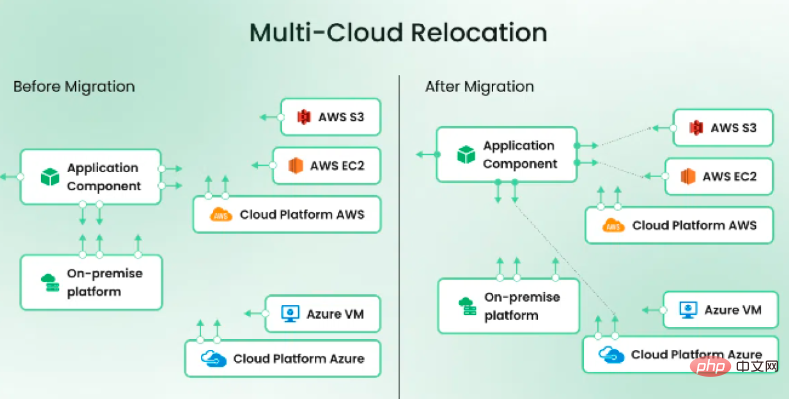
3. Multi-cloud refactoring
This approach involves restructuring and optimizing applications and workloads to span multiple clouds The provider operates efficiently. It focuses on adapting existing software to take advantage of different cloud environments.
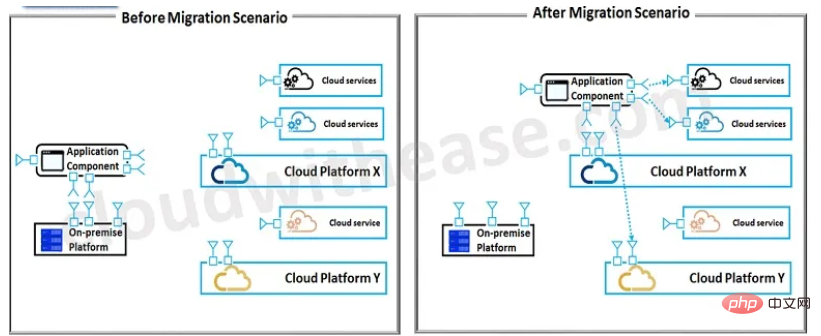
4. Public-private multi-cloud architecture
This architecture mainly divides servers into two categories: servers running in private clouds and public clouds. In this setup, the private cloud contains firewalls to ensure strong security, regulate access, and allow only essential elements to be shared.
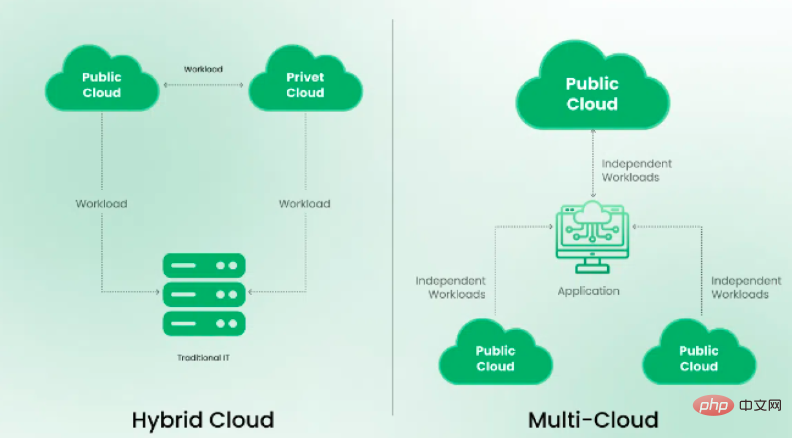
5. Multi-cloud re-bundling
It involves deploying a re-architected application in a multi-cloud environment, if the primary source encounters In the event of a failure, application continuity is ensured by seamlessly switching to an alternative deployment.
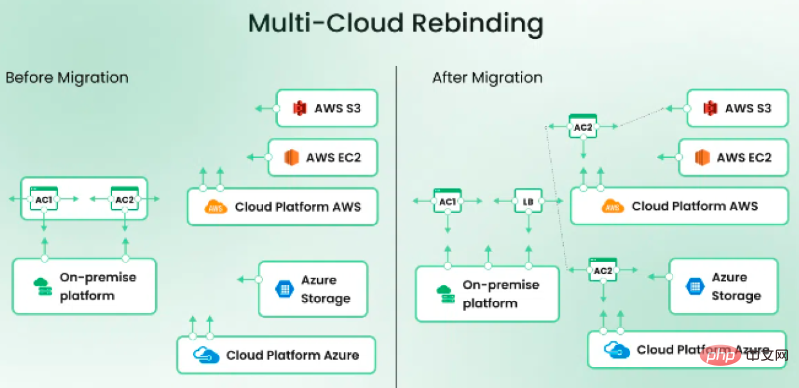
#6. Multi-cloud rebinding with cloud brokerage
This concept involves using cloud brokerage services to facilitate multi-cloud architectures Seamless integration and management of multiple cloud providers. The agent acts as an intermediary, optimizing the selection and use of cloud resources.
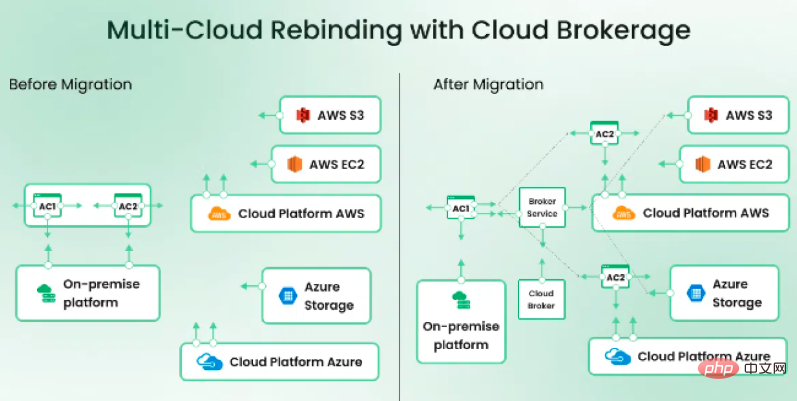
7. Multi-application modernization
Multi-application modernization is a strategy that involves updating and enhancing various applications simultaneously , typically in a multi-cloud environment. It is designed to modernize a variety of software solutions to meet contemporary performance, security and scalability standards.
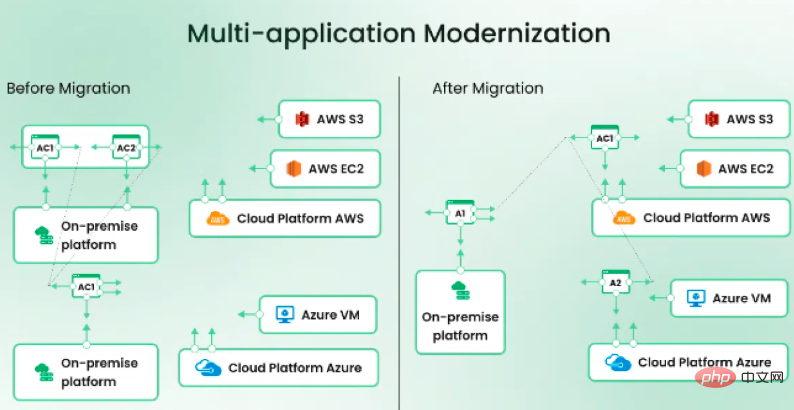
Navigating Multi-Cloud Environments
Multi-cloud computing represents a new frontier for IT professionals. Recognizing that a single cloud provider may not fully meet all of their needs, enterprises are increasingly adopting a multi-cloud approach, using multiple providers and cloud services to regain control of their digital infrastructure.
1. Choosing a Multi-Cloud Provider
Choosing the right provider for a multi-cloud environment can be just as challenging, if not more so, than choosing a single cloud provider. IT professionals must carefully evaluate vendors to determine which ones provide needed services while staying within budget constraints.
It's important to remember that even after choosing a provider, it's not necessary to establish permanent roots. Ongoing evaluation of the chosen provider is critical, and the ability to move to another provider if necessary ensures the adaptability and agility of your multi-cloud strategy.
2. Multi-cloud management and development considerations
Managing infrastructure in a multi-cloud model can bring many complexities. Before you dive in, it's important to map out the capabilities your organization needs and identify services or tools that can help manage them. As multi-cloud computing grows in popularity, vendors are developing new management tools to help track expenses and resources across cloud platforms.
Multi-cloud Adoption Challenges
According to HashiCorp’s first-ever State of the Cloud Strategy Survey, enterprises face the following challenges in adopting multi-cloud.

#1. Skills Shortage
Managing multi-cloud environments requires a variety of skills across a variety of cloud providers, services and tools. Many organizations face challenges in finding or training employees with the necessary expertise to effectively navigate the complexities of multiple cloud platforms.
2. Inconsistent Workflows
Inconsistent workflows between cloud providers can lead to operational inefficiencies and difficulty maintaining unified security and compliance standard. Adapting and adapting processes for multiple platforms can be a complex task.
3. Silos
Multi-cloud environments can inadvertently create silos within an organization, where different teams or departments manage cloud providers independently. These silos can hinder communication, collaboration, and sharing of best practices, leading to poor resource utilization.
4. Poor collaboration in multi-cloud environments
In multi-cloud settings, ineffective collaboration often hinders success. Silos, lack of communication, and inconsistent practices within teams can lead to duplication of resources, security breaches, and inefficiencies.
Latest trends in multi-cloud strategies
The following is a list of the latest trends in multi-cloud architecture.
1. Multi-cloud Dominates
Most organizations still favor a hybrid multi-cloud approach. Although adoption of a single public cloud increased slightly (from 9% to 11%), 87% still maintain a multi-cloud strategy, with 72% choosing a hybrid approach that combines public and private clouds.
2. Cloud-native security tools for multi-cloud environments
Multi-cloud environments have become a common standard in modern IT environments. In this changing paradigm, cloud-native security tools have become the primary solution for securing various components, including cloud infrastructure, cloud-native applications, and cloud services.
These tools are designed to address the unique security challenges in multi-cloud settings, providing a comprehensive and consistent approach to protect against ever-evolving threats and vulnerabilities.
3. Infrastructure as Code (IaC) for multi-cloud automation
Infrastructure as Code (IaC) is the cornerstone of multi-cloud automation. IaC changes the way we manage infrastructure elements such as networks, virtual machines, and storage. Rather than relying on traditional physical hardware configuration, IaC utilizes machine-readable definition files to define and orchestrate these components.
Some widely recognized IaC tools include Terraform, Pulumi, AWS CloudFormation, and Ansible.
4. Multi-cloud is necessary for success
A VMware survey shows that 95% of organizations believe that multi-cloud architecture is critical to success, and 52% It is believed that without a multi-cloud architecture, there is a risk of failure. This shift to multi-cloud is evident, as organizations are expected to double their reliance on public cloud between 2020 and 2027, with established companies leading the way.
The above is the detailed content of Diversity in the Cloud Era: A Deep Dive into Multi-Cloud Architecture. For more information, please follow other related articles on the PHP Chinese website!




